R-20 Album
USS R-20 Photo Album
This photo album was found in the archives of the Vallejo Naval & Historical Museum by Mr. Darryl Baker who has spent many hours copying these images to share. The album is from an unnamed sailor who apparently served aboard the USS R-20 in its very early years in service with the United States Navy. His small and imperfect camera has preserved remarkable images rarely seen in much bigger archives. The camera produced images of only 2.5 inches by 1.75 inches in size so the quality is not of the best but the images preserved are of the utmost importance.
Especially important are the photos showing the modifications to the hulls necessary for the transition from the 3 inch 23 caliber deck gun that these submarines were first outfitted with and the and preparations necessary for the installation of the much larger 4 inch 50 caliber gun. This necessitated the enlargement of the deck area with sponsons to accommodate the larger swinging area for this gun.
The photos were taken over a span of time. In some of the images the three vertical stripes on the chariot bridge are missing and in others they are present. The assumption is the lack of stripes are the earlier photos and the presence of them are later. No intention was made to sequence the photos by this time frame. They have been grouped by subject matter thereby creating a narrative on the page that is less scattered and more cohesive. It is clear now that the shapes painted on the bridge structures were done early in these submarines' lives and they wore them for a good majority of their service.
Running On The Surface ~ Deck Gun Raised
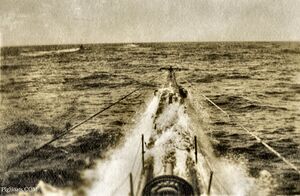
Category:Submarine plans and blueprintsThe USS R-20 heading out to sea on exercises with sister ships seen in the advance. The bow is dipping into the waves and washing over on to the deck.
These early R-Class submarines were built with the retractable 3"/23 caliber deck guns. The gun in this photo is in the raised position. Normally the gun would be retracted into it waterproof housing to protect it from sea water.
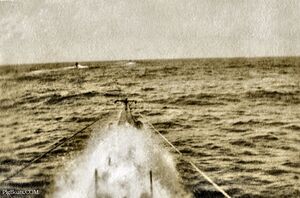
Photo#01: This next photo in the sequence shows the wave covering the deck and putting the gun underwater. It was unusual to leave this particular gun in the raised position while proceeding on the surface at speed and in these kind of seas.
One of the major reasons to make the gun retractable was to protect it from seawater induced corrosion, reducing maintenance requirements. With the waves inundating it in this fashion, the gun would have required careful and intensive maintenance once the boat returned to port.
Other submarines, most likely squadron mates, can be seen directly ahead and off the port bow. It is possible that the boats were proceeding to a gunnery training area when these photos were taken.
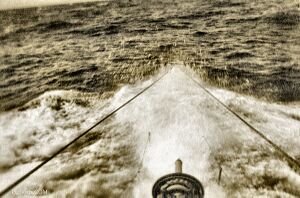
Photo#02: The R-20 continues to pound through the swells, temporarily submerging the entire forward deck all the way up to the gun, whose circular shield can just be seen.
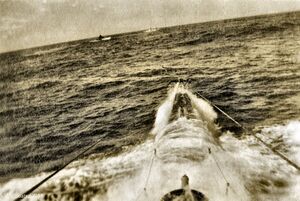
Photo#04: The R-20 continues driving through the ocean swells off the Southern California Coast. Probably for some Torpedo and maybe Gunnery practice.
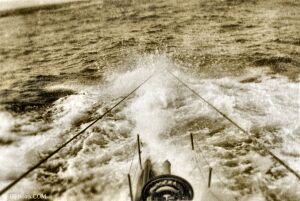
Photo#05: The R-20 continues driving through the ocean swells off the Southern California Coast. Probably for some Torpedo and maybe Gunnery practice.
Running On The Surface ~ Deck Gun Housed
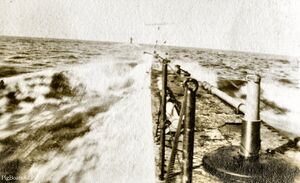
Photo#06: It is not known if this and the next photo were taken at the same time as the photos above. In this photo the gun has been retracted into a watertight tub that penetrated the pressure hull down into the forward battery room. The circular gun shield forms a watertight “hatch” that protected the gun breech and the elevation and training mechanisms. A tampion is inserted into the muzzle end to protect the rifled bore from corrosion.
Out of sight in this photo is the recoil dampening cylinder, which also penetrated the gun shield. It is behind the barrel. Lifelines and stanchions have been put in place on the edges of the deck to give the gun crew some level of protection from falling over the side.
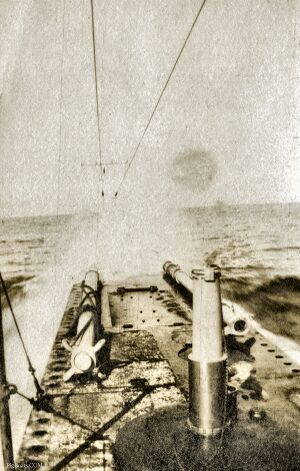
Another angle looking almost directly forward on the deck with a good look at the gun barrel. The two tubes or pipes on the deck are the torpedo loading mast and boom in their stowed positions. Later, when the larger deck gun will replace this one, these will be stored on the after deck leaving more room to train and point the large weapon.
The large rectangular deck hatch is the opening into the superstructure giving access to the slanted Torpedo Loading Hatch below it. It has a dual purpose. 1 to act as a deck cover for the opening and 2 to act as a slanted loading ramp for the torpedo to rest and slide on. Its hinges are on the after end of the hatch and it folds up and back making the ramp.
Firing Torpedo
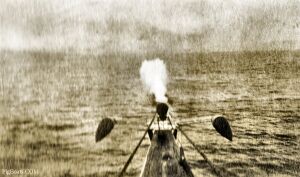
The R-20 fires a practice torpedo from either her #1 or #3 torpedo tube. As it exits the tube, after approximately 100 or so feet, it broaches the surface before diving back to its set running depth.
The puff of "smoke" is actually steam, as the Mk 9 and Mk 10 Bliss-Levitt torpedoes used by the R-boats had a wet-heater type engine. This engine used an alcohol fueled flame to heat water into steam, which then spun the turbine to turn a dual contra-rotating propeller.
The weapon left a trail of combustion gases and steam in its wake, creating the characteristic white trail behind it. If the weapon broached it would leave a puff of steam in the air. Broaching was neither intended or desired, as it gave warning to the target of the approaching torpedo.
These torpedoes had notoriously finicky depth keeping mechanisms, sometimes following a "sine wave" style up and down course to the target, with obvious negative implications to accuracy.
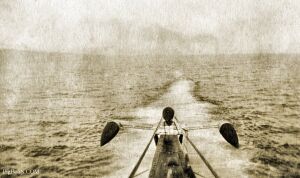
As the R-20 continues running on her assigned course, following the fired torpedo, its track of exhaust bubbles spreads out behind it. The next job for the R-20 will be to locate the torpedo and hoist it back aboard. It is then carefully lowered down into the torpedo room to be returned to the Naval Station for overhaul by the torpedo shop, and will be eventually reused.
The large wing-like array on the bow is the Y-tube sonar. It consists of three hydrophones covered by a flexible streamlined rubber "rat" that smooths the flow of water over the hydrophone, reducing ambient noise. The hydrophone wings are attached to a prominent U-shaped bracket that raised them above the deck, allowing a towing hawser to pass underneath.
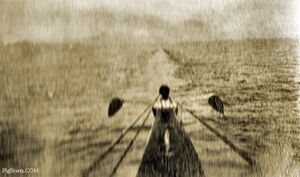
The track of exhaust bubbles thins out behind the fired torpedo as the R-20 still follows.
Retrieving Torpedo
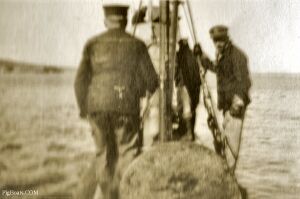
At the time frame this photo was taken it was not unusual for submarines during torpedo training exercises to locate and retrieve their fired practice torpedo. That is what it looks like is happening here. The torpedo fired in the above sequence has now been picked up and hoisted onto deck and is being loaded back down into the submarine.
Once back in port the torpedo will be pulled out of the submarine in a reverse of the procedure seen here.
With his back to the camera is most likely a Torpedoman Chief Petty officer but in this case and time frame it is likely this is a Chief Gunnersmate with a Torpedo rating.
On the right other man looks to be an officer supervising the process.
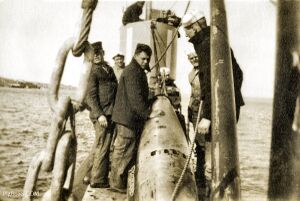
The Chief, on the left, seems to be paying attention to something or somebody who is forward of the camera.
A block and tackle is attached to the rear of the torpedo and the front of the bridge. This is to control the rate of descent of the torpedo. These weapons were 21 inches in diameter and 16.3 or 16.7 feet long. They weighed between 2200 and 2400 pounds each. Careful control of this much weight was vitally important. Amazingly, note the complete lack of lifelines for the safety of the crew. The Chief on the left is dangerously close to going over the side. One wrong move by any of the loading crew and someone gets wet.
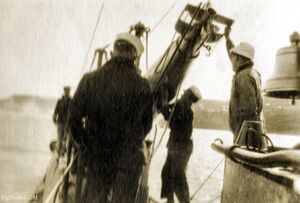
The view looking forward as the torpedo is lowered into the Torpedo Room. The officer is forward watching the operation. No sign of the Chief. Note the control arrangement on the tail of the torpedo. The contra-rotating propellers were intended to counter act the rolling torque of the torpedo’s engine. Without them the weapon would continuously roll along its axis after firing making depth and course control impossible.
Just to the right of the man closest to the camera hip is the barrel of the 3"/23 caliber deck gun. The gun is in its housed position.
The Crew
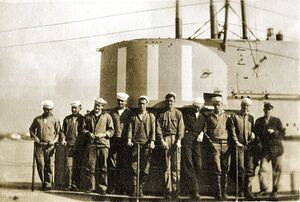
Nine men and a Chief. This looks a lot like a duty section. This is approximately one third of the crew size for this vessel.
A "Duty Section" comprises enough men to be able to take the vessel to sea and be able to fight it, if necessary, for a limited amount of time. Each section would have enough men to man the important duties aboard. The good thing about submarines and the training the crew have is the ability to know each others jobs and be able to navigate and fight the ship as necessary.
Note the man who is 5th from the left is wearing unique boots. He is seen several times throughout in these photos.
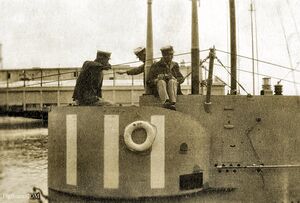
This looks to be three Officers on the bridge of the R-20. One is likely to be Lieut. Commander Alfred E. Montgomery, the Commanding Officer of the USS R-20. The names of other officers have not been located at this time.
This is a good view of the boat’s open-air bridge and periscope support shears. One officer is sitting between the two periscopes, and the third mast on the right is an extendable radio antenna mast. Just aft of the radio mast is a navigation light.
The wires connected to the angled brackets are mine and/or harbor defense net clearance wires. They can be seen more clearly in the photo below.
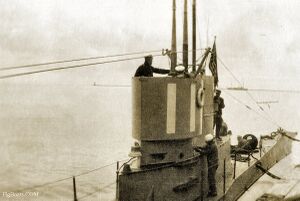
An officer on the bridge of the R-20. It could be Lieut. Commander Montgomery, the Commanding Officer. Another officer is to the right side of the bridge but only the top of his hat can be seen. An enlisted Sailor works on something on the side of the fairwater and perhaps a Chief is on the aft fairwater deck.
This is a good view of the R-20’s conning tower fairwater, and the clearance wires can clearly be seen. The conning tower itself is a small vertical cylinder, just big enough for two to three men to stand upright, and it contained a periscope station for #1 scope. It also had four very small glass windows, called deadlights, and two of them can be seen just to the left of the Sailor standing on deck. The conning tower is surrounded by a metal framework and plating called the fairwater, with the purpose of smoothing the flow of water around the tower, the periscopes, ventilation piping, and the bridge.
Looking at the bracing for the clearance wires you can see the "hooks" where the portable running lights were mounted. The Red and Green navigation lights were hung on these hooks and plugged into a water proof receptacle to supply them power.
In the background it looks like the Los Angles Lighthouse sitting on the end of that long breakwater.
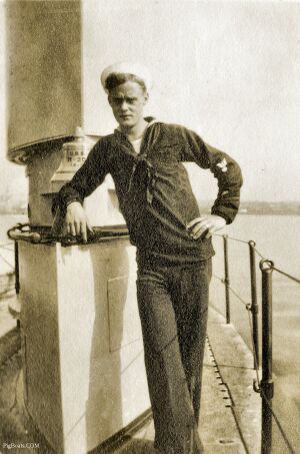
Nice portrait of an R-20 sailor. He is a First Class Electrician (Radio) with two Hashmarks meaning over 8 years of service. This could be the Photo Album's owner. The man is married by the ring on his left hand.
The Deck Gun
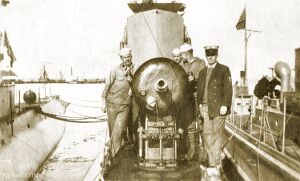
Submarine Historian David Johnston has these comments about this photo: "This is a good photo of the business end of the 3”/23 caliber Mk 9 "disappearing" deck gun. This weapon had a vertically sliding breech block and used fixed ammunition (i.e. shell and propellant put together in a brass cartridge, similar to a rifle bullet).
The base of the mount had brackets that held ready-use rounds that could be immediately loaded and quickly fired upon surfacing. One round can be seen adjacent to the knees of the Sailor on the left. Additional ammo was stored below and would be brought up by crewmen formed into a passing train.
The end of the recoil cylinder can be seen just below and to the left of the barrel. The weapon was light weight and easy to use, and when retracted into its tub provided little underwater drag. However, it was a low powered weapon that fired shells with little punch. It didn’t have the power necessary to finish off targets quickly. There have also been reports of the gun having a nasty tendency to retract into its tub with the recoil of firing. This had obvious negative safety implications for the crew."
The following is part of a paper written by Submarine Historian Jim Christley. This describes what a deck gun is and this gun in particular:
Nomenclature Note:
A deck gun type is defined by its bore diameter and bore length. Further refinement of the gun type is by the Mark and Modification number. The bore diameter is normally given in inches and the bore length is given in calibers. A caliber is one bore diameter. Thus for a 3”/50 gun, the bore diameter, measured land to land is 3”. The length of the bore is 50 calibers or 150 inches. Each major type also was given a Mark number by the Bureau of Ordnance (BuOrd). A gun could have the same bore size and length and be a different Mark. When discussing the entire range of 5” guns in the Navy, it is useful to use the Mark number. For submarine guns only, is normally not necessary. Modifications to a particular Mark were also numbered. Thus, a gun was fully described with its bore diameter, bore length, Mark and Mod numbers.
The 3”/23 is the Navy’s early attempt at creating a dual purpose gun. That is a single weapon that would be used both as an anti-surface and anti-aircraft gun. The diminutive 3”/23 Mark IX. It fired a projectile of about 13 pounds to a range of about 4.5 miles. Used in submarines it had no remote fire control system and was used in line of sight only. The mount was retractable in that the barrel assembly could be rotated to 90 degrees in elevation and the whole thing lowered into a containment cylinder. What appears as a splinter shield was the watertight cover that fitted snugly to the top of the containment. The gun’s drawbacks were that it had a fairly short range and it was prone to retracting when fired or at other inopportune times. Thus one kept ones toes away from the containment rim.
The man second from the right is wearing the same boots as was noted in an above photo.
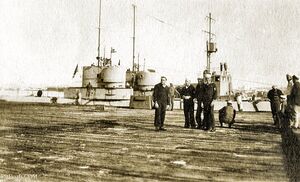

Page created by:
Ric Hedman & David Johnston
1999 - 2023 - PigBoats.COM©
Mountlake Terrace, WA, Norfolk, VA
webmaster at pigboats dot com
